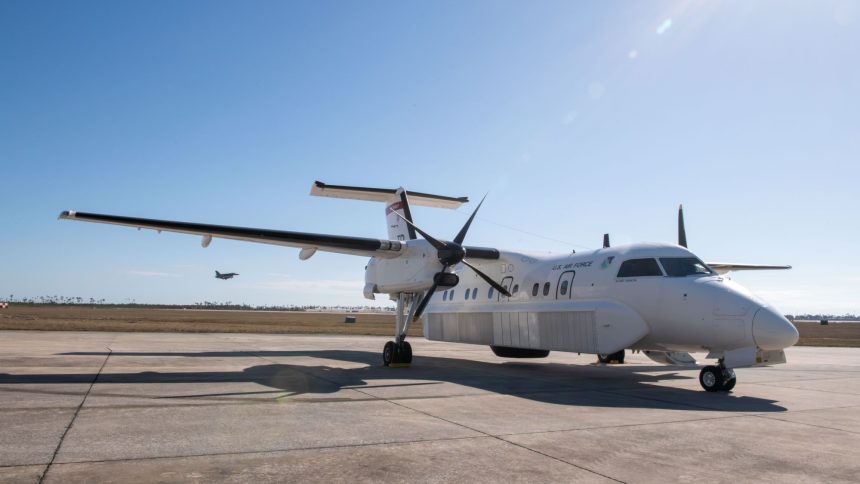The E-9A supports air-to-air weapon systems evaluation at Tyndall AFB providing range clearance, telemetry support and data relay.
The U.S. Air Force’s E-9A Widget firing range safety and surveillance aircraft completed its first strip and paint job in over a decade during a series of scheduled upgrades and maintenance, announced on Jul. 31, 2025 the Air Force Life Cycle Management Center (AFLCMC). Led by the E-9A Program Office at Tinker AFB in Oklahoma, the multi-contractor effort saw the work “completed on schedule and under budget, preserving operational timelines and maintaining aircraft performance and crew safety.”
The twin-turboprop aircraft ensures missile test zones over the Gulf of Mexico are clear of civilian vessels during live-fire exercises, providing “real-time surveillance and telemetry data to range safety officers at Tyndall AFB, Florida.” This makes its “operational reliability a top priority,” the AFLCMC release added.
Tyndall AFB is also one of the few bases with direct access to the Eastern Gulf of Mexico, consequently hosting a majority of the large-scale exercises and training missions which involve live air-to-air and anti-air missile fires. The area is also known as the Eglin Gulf Test and Training Range.
🖌️🛩️A classy refresh for the E-9A!
The @AFLCMCoffical E-9A Program Office at Tinker AFB completed a full E-9A strip-and-paint – the first in a decade.
The E-9A supports air-to-air weapons system eval, development & operational testing.https://t.co/zN0s3pVEYa#readiness pic.twitter.com/n4Ms5pnlUj
— U.S. Air Force Materiel Command ✈️ (@HQ_AFMC) August 4, 2025
E-9A Widget
Official images released by the Air Force show two E-9As, with serials 84-0048 and 84-0047. An earlier Dec. 17, 2020 release about the aircraft said the Department of Defense (DoD) operates only two E-9As with the 82nd Aerial Targets Squadron (82nd ATRS) for Weapons System Evaluation Program (WSEP).
The AFLCMC has however not mentioned whether both or only one of the airframes has undergone the repaint and upgrade and when this happened, only mentioning it was recently. One image accompanying the X post shows the Program Office’s civilian team members standing before the aircraft, while the other is from Aug. 26, 2008, and shows a side view of 84-048 taking off from Tyndall AFB during a Combat Archer exercise.
The E-9A has so far provided “support for air-to-air weapons system evaluation, development and operational testing at Tyndall AFB” by determining if the waters are “clear of civilian boaters and aircraft during live missile launches and other hazardous military activities,” another official USAF description said. Its capabilities are airborne ocean surface surveillance, telemetry recording and relay, according to the official factsheet.
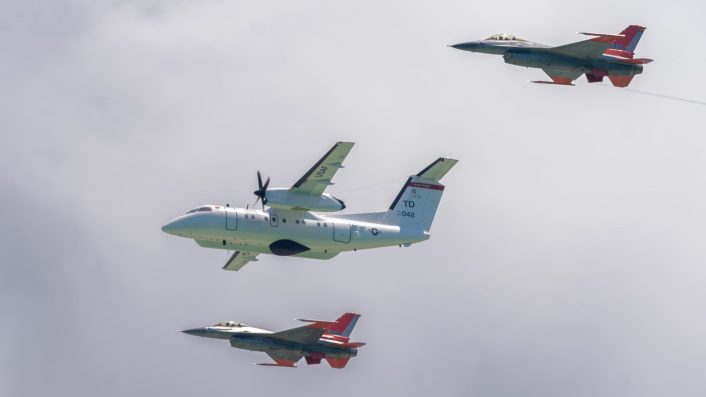
Based on the Bombardier (formerly De Havilland) Dash 8 , the aircraft was launched in 1980 as a larger successor to the UV-18A Twin Otter, and a more fuel-efficient and advanced technological alternative to the RC-7 Airborne Reconnaissance – Low. The 53rd Weapons Evaluation Group (WEG), that oversees the 82nd ATRS within 53rd Wing at Eglin AFB, received the first modified Dash-8 in 1988.
Its ocean surface surveillance capabilities are offered by a ventrally mounted AN/APS-143(V) -1 Airborne Sea Surveillance Radar, that can detect a person in a life raft up to 25 miles away. The aircraft also has another prominent fixed antenna array on the starboard (right) side, stretching from the rear to the front fuselage.
The antenna array is part of the telemetry and relay capabilities, as the E-9A can downlink the telemetry data it receives from test vehicles and drones to the range safety officer who coordinates with the testing squadron and the weapons launching platform for the live-fire activity, the Air Force explains. Over the Horizon UHF (Ultra-High Frequency) communications are used to transfer the data to ground sites.
Among the drone vehicles that can send their telemetry to the E-9A are the BQM-167A Subscale Aerial Targets, operated by the 82nd ATRS and launched by contractors for practice live-firing and WSEPs. The 82nd ATRS radar operators relay information about civilian boats to the 81st Air Control Squadron (81st ACS) in live missile tests during WSEPs.
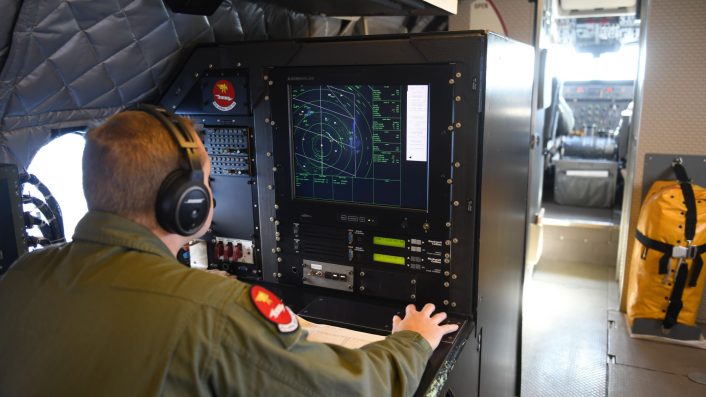
Strip paint and upgrade
The AFLCMC said the upgrade effort marks an achievement in “maintaining the mission readiness and longevity” of the specialized range safety aerial surveillance platform. The release quoted E-9A Program Office representative Aaron Thomas, who said the “high-visibility effort […] required close coordination and execution.”
The multi-contractor effort saw the E-9A Widget receiving the first full aircraft repaint in over a decade, while seamlessly integrating all aircraft upgrades. “Additionally, the government was able to take advantage of streamlining aircraft maintenance procedures for the removal and installation of critical mission components,” added the service.
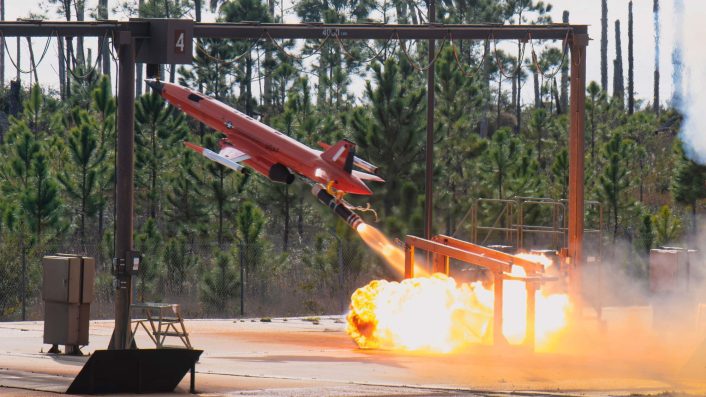
The successful completion of the E-9A strip and paint not only maintains the aircraft’s service life but also ensures the Air Force’s ability to conduct safe and effective weapons testing over open waters. The nature of the upgrades and the new systems has also not been revealed.
The E-9A is likely to play a prominent role in testing upcoming systems like the AIM-260 JATM (Joint Advanced Tactical Missile). A test article, possibly reproducing that missile, was spotted early in May installed on the nose of a CRJ700 used by Northrop Grumman as testbed aircraft.
The E-9A Widget has also supported other projects like the proof of concept for the advanced cruise missile, the Navy Fjord missile program, and live missile testing on the F-22 Raptor. “The mission of the E-9A Program Office is to develop, deliver and sustain integrated capabilities for its domestic and foreign partners to support flying training operations, test support and allied security,” the AFLCMC statement added.
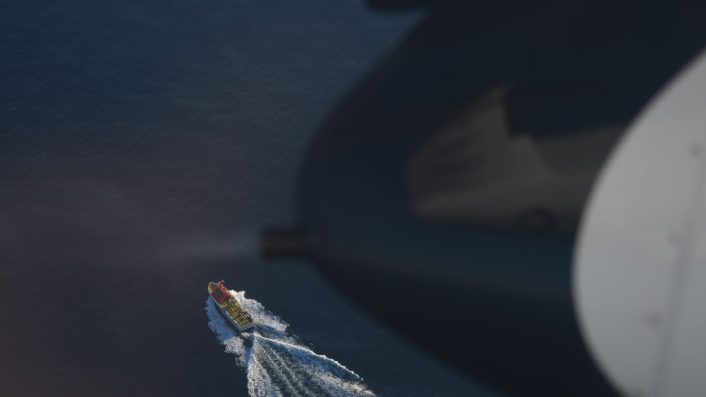
Boat and range safety tracking
In the Dec. 17, 2020 release featuring the E-9A Widget, the 325th Fighter Wing (325th FW) at Tyndall AFB showed images from inside aircraft and outside the aircraft during an unnamed test, depicting the environment in which the E-9A operates.
The images showed an 82nd ATRS airborne mission systems operator on the maritime radar’s console and an Air Force missile retriever ship used to clear waters of dangerous debris. Additionally, an F-22 Raptor from the 325th FW and a U.S. Navy F/A-18E Super Hornet assigned to the Strike Fighter Wing Atlantic at Naval Air Station Oceana were also shown.
Before fighter jets take off for air-to-air weapons system evaluation, development and operational testing, the testers rely on the 82nd ATRS’s E-9A Widget and the 81st ACS. The 82nd ATRS evaluator pilot Gary Acree called the Widget “critical for sea surveillance and relied on by many programs to get a shoot container for live-fire missions.”
USAF E-9A Widget 84-0048 #AE2211 as WIDGET48 arriving at BNA Nashville, TN. Huge thanks to @SR_Planespotter for the heads up! #AvGeek #AviationPhotography pic.twitter.com/4hnN9eB2qy
— Mr. Find Your Plane 📷✈📡 (@MrFindYourPlane) May 11, 2024
The 82nd ATRS radar operators relay the location of civilian boats back to the 81st ACS, who provide radar control and monitor the airspace. Airman 1st Class Aleah Ortega, 81st ACS command and control battle management operator, said the constant real-time surveillance in the Gulf of Mexico protects the boats in the gulf and determines a safe shoot track to fire the missiles.
E-9A Widget on display at the Space Coast Airshow! (84-0048) #potn pic.twitter.com/BYTJg75Nnu
— Ben Zuzolo (@PlaneSpotter3) April 4, 2019
The Airmen of the 81st ACS are also the only active duty Air Force squadron authorized to provide battle management command and control during live-fire air-to-air weapons evaluations.

